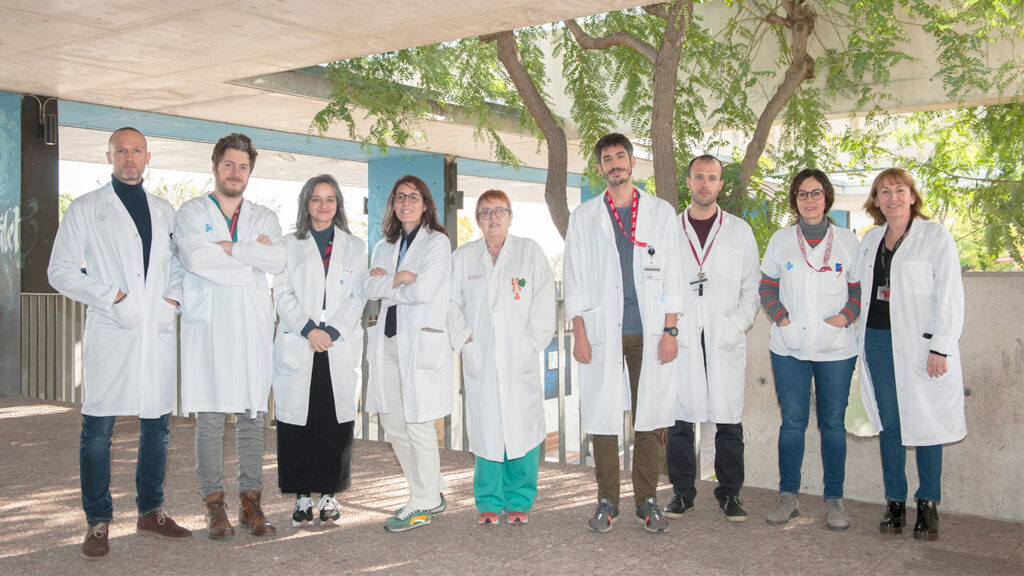A multidisciplinary team from the Bellvitge Biomedical Research Institute (IDIBELL) and the Bellvitge University Hospital (HUB) have located the origin of the reflex epileptic seizures triggered by the act of eating food: it is an operable lesion -an encephalocele- that It is located in the right temporal pole of the brain. The study has been published in the journal Epileptic Disorders, carried out by Dr. Raquel Tena-Cucala and coordinated by Dr. Mercè Falip, neurologist and researcher in the IDIBELL Neurological Diseases and Neurogenetics group and coordinator of the Epilepsy Unit of Neurology of the HUB.
An epileptic seizure occurs when there is a simultaneous and excessive discharge of neurons, interrupting normal brain function. These episodes are the manifestation of epilepsy, the second most common chronic neurological disorder that affects all age groups after headaches.
In fact, epilepsy etymologically means “surprise arrival”, since it is not possible to predict when a crisis will occur. However, only a small percentage – around 1% of patients – can suffer seizures triggered by a specific stimulus, called reflex seizures. There are reflex seizures with intermittent light stimulation, showering with hot water, listening to music, playing chess, mathematical calculations, and the act of eating, among other stimuli.
Specifically, IDIBELL and the Hospital de Bellvitge have focused their research efforts on reflex epileptic seizures in the act of eating. “They can be produced by tastes, smells, by the act of swallowing or by proprioceptive stimuli in the mouth, esophagus, stomach or by other visuospatial stimuli“, according to the neurologist.
Despite being an infrequent type of this neurological disorder, the HUB Epilepsy Unit -made up of neurologists, neurosurgeons, neuroradiologists and nuclear medicine specialists, neuropsychologists, and neurophysiologists- has collected and evaluated the clinical characteristics of eight patients to determine the origin of the reflex crises that they suffer as a result of food and eating.
As published in the journal Epileptic Disorders, five of the patients treated at Bellvitge triggered seizures during the meal due to the taste or texture of the food, and three of them due to activities related to the act of eating, such as cutting food. Taste-induced seizures originated in the right temporal lobe in five patients, and in four of them, a specific lesion was found in the right temporal pole called an encephalocele. This injury occurs when a part of the brain herniates due to weakness of the meninges or the bones at the base of the skull.
Discovering this lesion has made it possible to completely control the seizures after a surgical intervention in two of these patients, performed by the Neurosurgery Service of the HUB. This surgery consists of the resection of the pole of the right temporal lobe and the placement of a mesh to prevent a herniation of the brain from occurring again.
What is epilepsy and how to act in a crisis?
“Epilepsy is not a disease, it is a symptom that can correspond to many diseases,” explained the neurologist Mercè Falip about this chronic condition of the nervous system suffered by 8 out of 1,000 people. “It can start for many different reasons with a lesion in the cortex, the external part of the brain, as a common feature: a head injury, a tumor, a problem at birth, encephalitis or degenerative diseases such as Alzheimer’s, among others“, has pointed out the IDIBELL researcher and coordinator of the Epilepsy Unit of the University Hospital of Bellvitge.
“In an epileptic seizure the best way to act is to make sure that the person is not at risk of falling and letting it happen“, explained Dr. Falip.
The Bellvitge Biomedical Research Institute (IDIBELL) is a biomedical research center created in 2004. It is participated by the Bellvitge University Hospital and the Viladecans Hospital of the Catalan Institute of Health, the Catalan Institute of Oncology, the University of Barcelona and the City Council of L’Hospitalet de Llobregat.
IDIBELL is a member of the Campus of International Excellence of the University of Barcelona HUBc and is part of the CERCA institution of the Generalitat de Catalunya. In 2009 it became one of the first five Spanish research centers accredited as a health research institute by the Carlos III Health Institute. In addition, it is part of the “HR Excellence in Research” program of the European Union and is a member of EATRIS and REGIC. Since 2018, IDIBELL has been an Accredited Center of the AECC Scientific Foundation (FCAECC).

